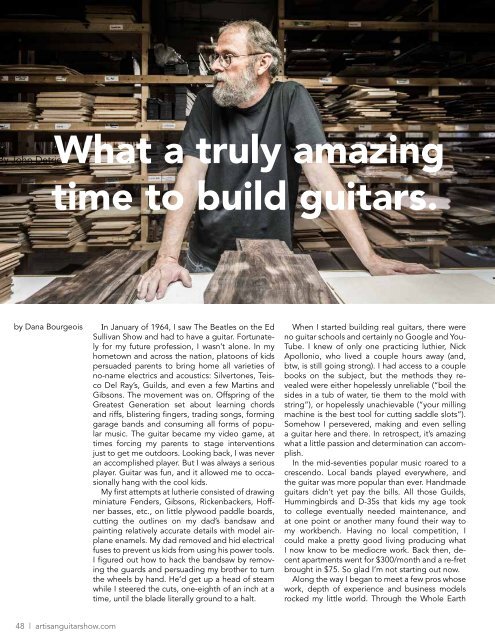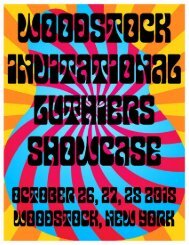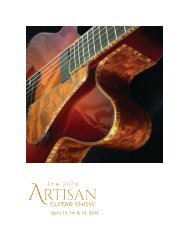2019 AGS Magazine_V5
Magazine for the 2019 Artisan Guitar Show
Magazine for the 2019 Artisan Guitar Show
You also want an ePaper? Increase the reach of your titles
YUMPU automatically turns print PDFs into web optimized ePapers that Google loves.
y John DetrickWhat a<br />
by Dana Bourgeois<br />
truly amazing<br />
time to build guitars.<br />
In January of 1964, I saw The Beatles on the Ed<br />
Sullivan Show and had to have a guitar. Fortunately<br />
for my future profession, I wasn’t alone. In my<br />
hometown and across the nation, platoons of kids<br />
persuaded parents to bring home all varieties of<br />
no-name electrics and acoustics: Silvertones, Teisco<br />
Del Ray’s, Guilds, and even a few Martins and<br />
Gibsons. The movement was on. Offspring of the<br />
Greatest Generation set about learning chords<br />
and riffs, blistering fingers, trading songs, forming<br />
garage bands and consuming all forms of popular<br />
music. The guitar became my video game, at<br />
times forcing my parents to stage interventions<br />
just to get me outdoors. Looking back, I was never<br />
an accomplished player. But I was always a serious<br />
player. Guitar was fun, and it allowed me to occasionally<br />
hang with the cool kids.<br />
My first attempts at lutherie consisted of drawing<br />
miniature Fenders, Gibsons, Rickenbackers, Hoffner<br />
basses, etc., on little plywood paddle boards,<br />
cutting the outlines on my dad’s bandsaw and<br />
painting relatively accurate details with model airplane<br />
enamels. My dad removed and hid electrical<br />
fuses to prevent us kids from using his power tools.<br />
I figured out how to hack the bandsaw by removing<br />
the guards and persuading my brother to turn<br />
the wheels by hand. He’d get up a head of steam<br />
while I steered the cuts, one-eighth of an inch at a<br />
time, until the blade literally ground to a halt.<br />
When I started building real guitars, there were<br />
no guitar schools and certainly no Google and You-<br />
Tube. I knew of only one practicing luthier, Nick<br />
Apollonio, who lived a couple hours away (and,<br />
btw, is still going strong). I had access to a couple<br />
books on the subject, but the methods they revealed<br />
were either hopelessly unreliable (“boil the<br />
sides in a tub of water, tie them to the mold with<br />
string”), or hopelessly unachievable (“your milling<br />
machine is the best tool for cutting saddle slots”).<br />
Somehow I persevered, making and even selling<br />
a guitar here and there. In retrospect, it’s amazing<br />
what a little passion and determination can accomplish.<br />
In the mid-seventies popular music roared to a<br />
crescendo. Local bands played everywhere, and<br />
the guitar was more popular than ever. Handmade<br />
guitars didn’t yet pay the bills. All those Guilds,<br />
Hummingbirds and D-35s that kids my age took<br />
to college eventually needed maintenance, and<br />
at one point or another many found their way to<br />
my workbench. Having no local competition, I<br />
could make a pretty good living producing what<br />
I now know to be mediocre work. Back then, decent<br />
apartments went for $300/month and a re-fret<br />
brought in $75. So glad I’m not starting out now.<br />
Along the way I began to meet a few pros whose<br />
work, depth of experience and business models<br />
rocked my little world. Through the Whole Earth<br />
Catalogue I learned that Michael Gurian ran what<br />
would now be called a boutique production shop,<br />
in Hinsdale, NH. I made quite a few round trip,<br />
eight-hour drives to Hinsdale for the privilege of<br />
selecting and purchasing tonewoods, getting my<br />
first peeks at a real guitar operation, and receiving<br />
occasional words of wisdom from someone who<br />
knew a lot more than I did. Walter Lipton built steel<br />
string and classical guitars in Orford, NH, and also<br />
sold wood. And Michael Cone built world class<br />
classical guitars, using only hand tools, in an offgrid<br />
house New Vinyard, Maine. Michael turned<br />
me on to the Guild of American Luthiers. I became<br />
a member and attended their 1979 convention in<br />
Boston, where I met John Monteleone, Steve Klein<br />
and David Russel Young. Wow.<br />
By the time the 80s rolled around, I had saturated<br />
my southern Maine market. I needed either to<br />
project my services to a bigger community or relocate<br />
from the area my ancestors had settled back<br />
in the mid-eighteenth century. Fortunately, I didn’t<br />
relocate. The Big Time came to me when I met<br />
Eric Schoenberg and began repairing and restoring<br />
real vintage guitars from his personal collection<br />
and from The Music Emporium, the shop he coowned<br />
in Cambridge, MA. The first half of the decade<br />
was spent making bi-weekly or monthly treks<br />
to Cambridge to pick up and drop off repair work.<br />
Soon I and my apprentice, TJ Thompson, had a<br />
serious backlog of vintage repair and restoration<br />
work. During those Boston trips I got to meet and<br />
later know a few of my acoustic<br />
guitar heroes, including Russ<br />
Barenberg, Tony Rice, Norman<br />
Blake and Doc Watson. More<br />
importantly, I got to hear them<br />
play guitars I had built. The ideal<br />
I strove for, and still do, was<br />
the sound of a truly great vintage<br />
guitar in the hands of a<br />
great player. In no way is that<br />
actually possible to achieve…<br />
probably ever, and certainly<br />
not back then. But it’s good to<br />
have standards and even better<br />
to understand exactly how<br />
one measures up to them. Tony<br />
Rice once told me, “This guitar<br />
doesn’t quite make it, man.”<br />
Though I still wince at the recollection,<br />
Tony’s unique brand of<br />
kindness and honesty probably<br />
was, in the big picture, at least<br />
as valuable as the last couple<br />
digits on my right hand.<br />
In the mid-eighties, Eric asked<br />
Chris Martin if C.F. Martin’s new<br />
Custom Shop would build a guitar along the lines<br />
of a cutaway OM I had by that time developed.<br />
Chris answered that it wasn’t anything they’d consider<br />
building under the Martin name. And that’s<br />
how Schoenberg Guitars was born, with me as a<br />
founding co-partner. For a few years I selected<br />
wood, made specialty parts, and voiced guitars at<br />
the Martin factory like it was no<br />
big deal. Based on my Schoenberg<br />
Guitars experience, I later<br />
got a gig with Gibson as a process<br />
design consultant, helping<br />
the company open an acoustic<br />
guitar factory in Bozeman,<br />
Montana. Then I got hired by<br />
PRS to help develop a business<br />
plan and product line for an<br />
acoustic guitar division. Around<br />
the dawn of the 90s, Paul had<br />
decided that he wasn’t yet<br />
ready for acoustics and I was<br />
on my own again. That decade<br />
flew by.<br />
After spending two years<br />
planning someone else’s acoustic<br />
guitar venture, having a go<br />
on my own seemed like the natural<br />
next thing to do. The time<br />
was right. By the early 90s, many<br />
of the kids I grew up and went<br />
to college with found themselves<br />
living in better neighborhoods<br />
and rediscovering the<br />
48 | artisanguitarshow.com<br />
artisanguitarshow.com | 49




